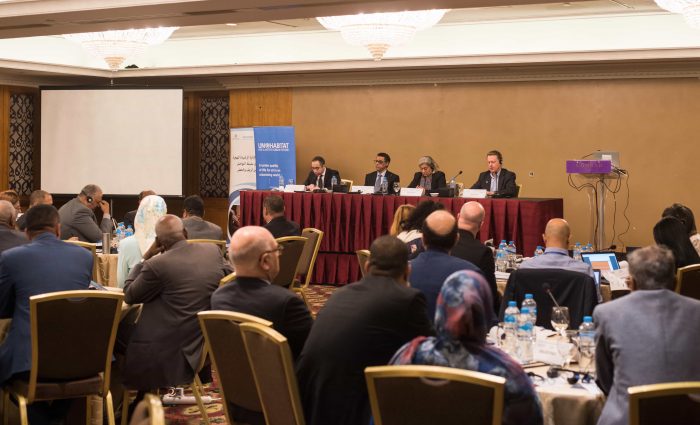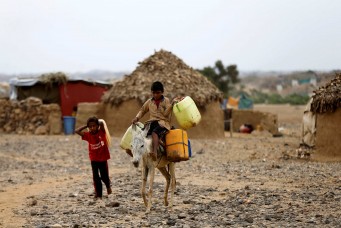The Country to City Continuum
Government leaders and public policy experts attended the Regional Workshop on Strengthening Migration Governance Across the Rural Urban Continuum.

Attendees and speakers at the Regional Workshop on Strengthening Migration Governance Across the Rural Urban Continuum at the Conrad Hotel in Cairo, Egypt November 26, 2019. Audrey Lodes/Cairo Review
United Nations organizations and regional leaders met in Cairo from November 26 to November 28 to discuss how to face challenges in migration. While the three-day workshop at the Conrad Hotel dealt with transnational migration, the primary focus was on a phenomenon which each country in the Middle East and North Africa (MENA) region is grappling: internal rural to urban migration.
Three United Nations agencies—the Food and Agriculture Organization (FAO), Human Settlement Programme (UN Habitat), and the International Organization for Migration (IOM)—jointly organized the event which brought together leaders and policy-makers from Egypt, Morocco, Iraq, Algeria, Tunisia, Mauritania, Palestine, Yemen, Sudan, Lebanon, and Jordan as well as participants from outside the MENA region.
“Internal migration is three times (the size) of international migration,” said Kristina Mejo, the IOM’s Senior Regional Liaison and Policy Officer. Consequently, the attention and support of local governments and international organizations to the rural-urban migration continuum within nations is of pressing import.
Carmela Godeau, IOM’s Regional Director, stressed that UN agencies must support local governments as states look for new ways to promote good governance and implement the target objectives of the global compact for migration. The regional director of the IOM also discussed the need to strengthen existing livelihood options for rural communities.
Promoting local rural development appeared to be an important key to lessening the urbanizing strain on governments. As roads and infrastructure have spread to a nation’s countryside, rural-based capital has increased. This increase has been seen in the growth of agricultural based industries. “We are living in a world where the urban-rural divide is faster,” stressed Ana Paula De la O Campos, Program Advisor in the FAO.
Half a century ago, the driver which moved populations from rural villages to cities was generally connected to the better economic and educational opportunities in urban milieus. However, in recent years, the sharp increase in internal migration to urban centers is linked to environmental issues such as land degradation and water scarcity. According to a joint publication by Migration Specialist Carol Wegner and Dalia Abulfotuh, an expert in rural development at FAO, water scarcity will likely affect, “80-100 million people in the MENA region by 2025, and land degradation will be intensified with the onset of climate change.”
Many migration experts and country representatives emphasized that, without an approach that combines efforts of UN agencies with local governments, migration could threaten food security and agriculture in both rural and urban areas across the MENA region and beyond.
Government policies can play a key role in mitigating adverse effects of internal migration with proper support and policies. Therefore, both the drivers of migration and the implications of movement must be addressed. Timothy McNair, Deputy Director of the UN Habitat said, “Rural and urban areas depend on each other. We must have balanced investments across each.”
Some felt that the adverse impacts of rural-urban migration can be mitigated by strengthening migration governance in urban centers through improved data collection and focusing more on the actual benefits of migration. Abulfotuh said that migrants can contribute to and strengthen host communities by exchanging skills and technologies, providing services, and engaging in the transfer of capital through remittances.
Other attendees emphasized strengthening rural communities as a way to improve life quality and increase income levels in rural settings. Campo emphasized the economic revitalization of rural communities as a way forward.
Exploring ways to transform challenges to solutions were at the forefront of each discussion. Activities including proposing intervention models, listening country-specific priorities, and breaking into small groups were all geared toward promoting a collaborative, thought-provoking experience. Each topic in the groups was covered from different angles by the panelists and provided opportunities for discussion and engagement with the participants.
Working to mitigate obstacles faced by migrants across the board relies on informed policies that take into consideration how local, national and regional entities can work together to address the needs of the population. This relies on understanding individual country dynamics and complex relationships between climate change, development, and mobility.
Addressing the root causes of adverse drivers of migration is not only a regional issue, but a global imperative. In 2017 alone, there were close to 28 million international migrants and 7.6 million refugees originating from the MENA region. The mass movement of people from rural to urban communities will continue to have transformative impacts on social, economic, and environmental landscapes in the coming years.
The workshop embodied the collaborative, multi-sector cooperation necessary to strive toward common goals of the Global Compact on Migration and tackle some of the most pressing migration issues in the rural to urban continuum.
Audrey Lodes is an assistant editor and photographer at the Cairo Review of Global Affairs. Find her on Twitter at @audreylodes.
Read MoreSubscribe to Our Newsletter




